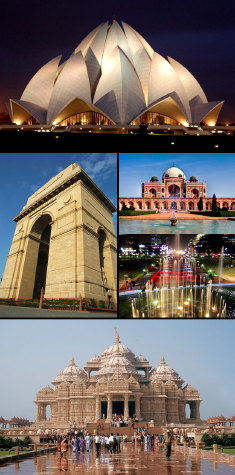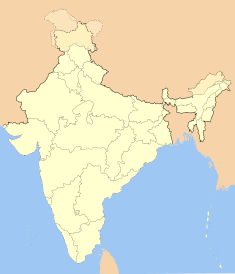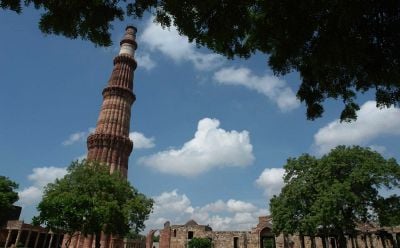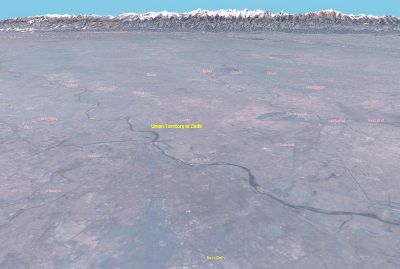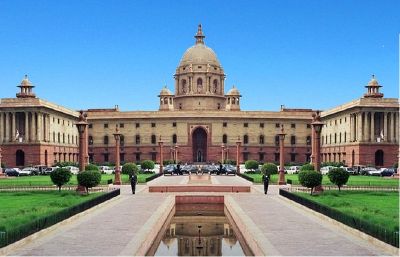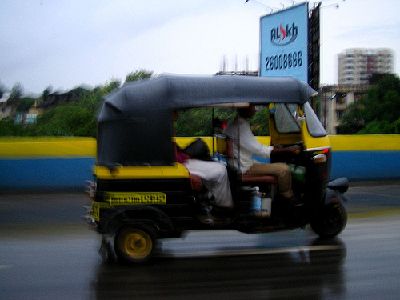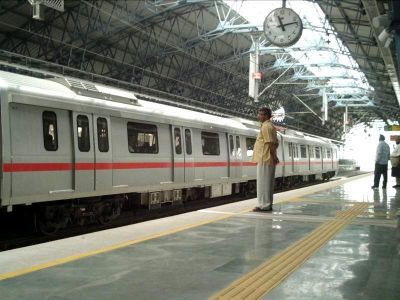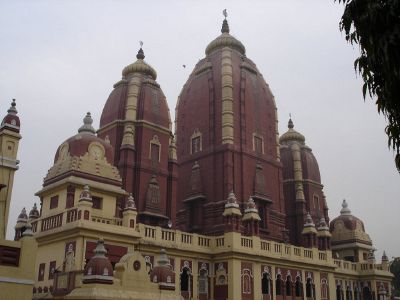Delhi
| Delhi National Capital Territory of Delhi • India | |
| Coordinates: | |
| Time zone | IST (UTC+5:30) |
| Population • Metro • Urban |
16,787,941 (2011) • 28,514,000 • 16,349,831 |
| Lt. Governor | Vinai Kumar Saxena |
| Chief Minister | Arvind Kejriwal (AAP) |
| Codes • Pincode |
• 110001-110098, 1100xx |
| Website: delhi.gov.in | |
Coordinates:
Delhi, sometimes referred to as Dilli or Dhilli, is the second largest metropolis in India after Mumbai. Located in northern India on the banks of the River Yamuna, Delhi has the political status of a federally-administered union territory known as the National Capital Territory of Delhi (NCT). A constitutional amendment in 1991 gave Delhi a special status among the Union Territories; Delhi has its own legislative assembly with limited powers.
Delhi is one of the oldest continually inhabited cities in the world. Having been the capital of several empires in ancient India, Delhi was a major city on the old trade routes from northwest India to the Gangetic Plains. Many ancient monuments and archaeological sites remain as a testament to Delhi’s rich and diverse history. The Mughals built a section of the city (now known as Old City or Old Delhi) that served as the capital of Mughal Empire for a long period. During the British Raj, New Delhi was built as an administrative quarter of the city. New Delhi was declared the capital of India after India gained independence from British rule in 1947. As the seat of the Government of India, New Delhi houses important offices of the federal government, including the Parliament of India. Delhi has grown up to be a cosmopolitan city owing to the immigration of people from across the country.
Like many other large cities of the world, Delhi suffers from urbanization problems such as pollution, traffic congestion and scarcity of resources. The rapid development and urbanization of Delhi and surrounding areas coupled with the high average income of the populace has largely eclipsed socio-cultural traits that once represented the city.
| This article contains Indic text. Without proper rendering support, you may see question marks or boxes, misplaced vowels or missing conjuncts instead of Indic text. |
Etymology
The etymology of "Delhi" is uncertain. The most common view is that the name originates from Raja Dhilu, a king who reigned in the first century B.C.E., and that the various names by which it has been known (Dilhika, Delhi, Dehli, Dilli, and Dhilli) have been corruptions of the king’s name. One of the most ancient names for Delhi is Dilhaka. Some historians believe that the name is derived from Dilli, a corruption of dehleez or dehali—Hindustani for 'threshold'—and symbolic of city as a gateway to the Indo-Gangetic Plain.[1]
A popular etymology for Dehli comes from the legend of the king Anangapala II, who attempted to erect a pillar on the head of the King of Snakes (Vasuki), an action that would guarantee the permanence of his dynasty. He doubted the pillar was being put in the correct location, so he had it withdrawn. Upon removal of the pillar, the blood of the snake was found on it, so he had it replaced. Nevertheless, because of Anangapala’s lack of confidence, the pillar and his kingdom were thereafter considered dhilla, that is, ‘loose.’[1]
History
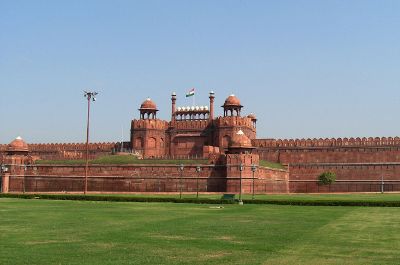
Human habitation was probably present in and around Delhi during the second millennium B.C.E. and before, as evidenced by archaeological relics.[3] The city is believed to be the site of Indraprastha, (built c. 1400 B.C.E.) the legendary capital of the Pandavas in the Indian epic Mahabharata.
Settlements grew from the time of the Mauryan Empire (c. 300 B.C.E.) [3] The Tomara dynasty founded the city of Lal Kot in 736 C.E.. The city returned to prominence in the twelfth century when Prthviraja III, ruler of the Cauhan (Cahamana) conquered Lal Kot in 1180 C.E. and renamed it Qila Rai Pithora, making it the capital of the Cauhan. Prthviraja III was defeated in 1192 by the Afghan Muhammad Ghori, passing the city into Muslim hands. In 1206, Qutb-ud-din Aybak, the first ruler of the Slave Dynasty established the Delhi Sultanate and chose Delhi as his capital. Qutb-ud-din started the construction the famous tower Qutub Minar and Quwwat-al-Islam (might of Islam), the earliest extant mosque in India.[4]
There are seven ancient and historic cities of Delhi. The first is classified as the original site of Delhi, and includes all those who ruled it. Ala-ud-Din Khalji built the second city of Delhi at Siri, three miles northeast of the Qutb Minar. The third city of Delhi was built by Ghiyas-ud-Din Tughluz (1320-1325) at Tughlakabad but had to be abandoned in favor of the old site near the Qutb Minar because of a scarcity of water. Muhammad ibn Tughluq, his successor, extended the city further northeast; this became the fourth city of Delhi. Muhamad ibn Tughluq’s successor, Firuz Shah Tughluq, abandoned this site altogether and in 1354 moved his capital further north near the ancient site of Inraprastha and founded the fifth city of Delhi, Firuzabad, which was situated in what is now the Firoz Shah Kotla area.
Delhi was sacked at the end of the fourteenth century by Timur (Tamerlane) and the last of the sultan kings moved the capital from Delhi, so it diminished in importance. Notwithstanding, it was ruled by Sultan kings until 1526, when Babur, the first Mughal ruler, reestablished Delhi as the seat of his empire. His son Humayun built a new city, Din Panah, which was shortly thereafter overthrown and rebuilt by Sher Shah, thus creating the sixth city of Delhi. Mughal emperors continued to rule Delhi through a period of decline until 1638, when emperor Shah Jahan laid the foundations of the seventh city of Delhi, Shahjahanabad, which has come to be known as Old Delhi.
The Mughal Empire fell in the mid-eighteenth century, and Delhi experienced many more changes- raids by the Maratha (a people of peninsular India), the invasion of Nader Shah of Persia, and a brief spell of Maratha rule, culminating in the arrival of the British in 1803. In 1857, during the Indian mutiny, the city was seized for several months but eventually returned to British rule. Shortly after the Rebellion, Calcutta was declared the capital of British India and Delhi was made a district province of the Punjab. In 1911, Delhi was again declared as the capital of British India. Parts of the old city were pulled down to create New Delhi; a monumental new quarter of the city designed by the British architect Edwin Lutyens to house the government buildings. New Delhi, also known as Lutyens' Delhi, was officially declared as the seat of the Government of India and the capital of the republic after independence on 15 August 1947. During the partition of India thousands of Hindu and Sikh refugees from West Punjab and Sindh migrated to Delhi.
In 1984, the assassination of Indira Gandhi (Prime Minister of India) led to violent backlash against the Sikh community, resulting in over two thousand seven hundred deaths.[5] The Constitution (Sixty-ninth Amendment) Act, 1991 declared the Union Territory of Delhi to be formally known as National Capital Territory of Delhi.[6] The Act gave Delhi its own legislative assembly, though with limited powers.[6]
Geography
The National Capital Territory of Delhi is spread over an area of 573 mi² (1,483 km²), of which 302 mi² (783 km²) is designated rural, and 270 mi² (700 km²) urban. Delhi has a maximum length of 32 mi (48.48 km) and the maximum width of 30 mi (48 km).
Delhi is located in northern India. It borders the Indian state of Uttar Pradesh on the south and Haryana on the west. Delhi lies almost entirely in the Gangetic Plains. Two prominent features of the geography of Delhi are the Yamuna flood plain and the Delhi ridge. The low-lying Yamuna flood plains provide fertile alluvial soil suitable for agriculture. However, these plains are prone to recurrent floods. Reaching up to a height of 1043 ft (318 m) the ridge forms the most dominating feature in this region. It originates from the Aravalli Range in the south and encircles the west, northeast and northwest parts of the city. Yamuna, a sacred river in Hinduism, is the only major river flowing through Delhi. Most of the city, including New Delhi, lies west of the river. East of the river is the urban area of Shahdara. Delhi falls under seismic zone-IV, making it vulnerable to major earthquakes.[7]
Climate
Delhi has a semi-arid climate with high variation between summer and winter temperatures. Summers are long, from early April to October, with the monsoon season in between. During the summer season, the city faces extreme power and water shortages.[8] Winter starts in November and peaks in January and is notorious for its heavy fog, which often disrupts road, air, and rail traffic. Extreme temperatures range from 30.9 ºF (-0.6 ºC). The annual mean temperature is 77 ºF (25 ºC); monthly mean temperatures range from 58 ºF to 92 ºF (14 ºC to 33 ºC). The average annual rainfall is approximately 28 in (714 mm), most of which is during the monsoons in July and August. The average date of the advent of monsoon winds in Delhi is June 29.
Civic Administration
The Delhi metropolitan area lies within the National Capital Territory of Delhi (NCT). The NCT has three local municipal corporations: Municipal Corporation of Delhi (MCD), New Delhi Municipal Council (NDMC) and Delhi Cantonment Board. MCD is one of the largest municipal corporations in the world providing civic amenities to an estimated 13.8 million people. The capital of India, New Delhi, falls under the administration of NDMC. The chairperson of the NDMC is appointed by the Government of India in consultation with the Chief Minister of Delhi.
Delhi has four major satellite cities which lie outside the National Capital Territory of Delhi. These are Gurgaon and Faridabad (in Haryana), and New Okhla Industrial Development Authority (NOIDA) and Ghaziabad (in Uttar Pradesh). Delhi is divided into nine districts. Each district (division) is headed by a Deputy Commissioner and has three subdivisions. A Subdivision Magistrate heads each subdivision. All Deputy Commissioners report to the Divisional Commissioner. The District Administration of Delhi is the enforcing department for all kinds of State and Central Government policies and exercises supervisory powers over numerous other functionaries of the Government.
The Delhi High Court exercises jurisdiction over Delhi. Delhi also has lower courts; the Small Causes Court for civil cases, and the Sessions Court for criminal cases. The Delhi Police, headed by the Police Commissioner, is one of the largest metropolitan police forces in the world. Delhi is administratively divided into nine police-zones, which are further subdivided into 95 local police stations.
Government and Politics
As a special Union Territory, the National Capital Territory of Delhi has its own Legislative Assembly, Lieutenant Governor, Council of Ministers and Chief Minister. The legislative assembly seats are filled by direct election from territorial constituencies in the NCT. However, the Union Government of India and the Government of National Capital Territory of Delhi jointly administer New Delhi. The legislative assembly was re-established in 1993 for the first time since 1956, with direct federal rule in the span. In addition, the Municipal Corporation of Delhi (MCD) handles civic administration for the city as part of the Panchayati Raj act. New Delhi, an urban area in Delhi, is the seat of both the State Government of Delhi and the Government of India. The Parliament of India, the Rashtrapati Bhavan (Presidential Palace) and the Supreme Court of India are located in New Delhi. There are 70 assembly constituencies and seven Lok Sabha (Indian parliament's lower house) constituencies in Delhi.
Infrastructure
The previously mentioned influx of immigrants into Delhi has helped cause a number of seemingly unsolvable problems to the city’s infrastructure. Rapid development has required all the ingenuity of city planners to provide sufficient clean water, sanitation, and power for the population.
Water supply
The water supply in Delhi is managed by the Delhi Jal Board (DJB). The Bhakra storage is the largest water source for DJB, followed by river Yamuna and Ganges. With falling groundwater level and rising population density, Delhi faces severely acute water shortage.
Electricity
In 1997, Delhi Vidyut Board (DVB) replaced Delhi Electric Supply Undertaking which was managed by the MCD. The DVB itself cannot generate adequate power to meet the city's demand and borrows power from India's Northern Region Grid. As a result, Delhi faces a power shortage resulting in frequent blackouts and brownouts, especially during the summer season when energy demand is at its peak. Several industrial units in Delhi rely on their own electrical generators to meet their electric demand and for back up during Delhi's frequent and disruptive power cuts. The power sector in Delhi was handed over to private companies in recent years.
Economy
Delhi is the largest commercial center in northern India. Delhi's workforce constitutes about one third of the population. Key service industries are information technology, telecommunications, hotels, banking, media and tourism. Construction, power, health and community services, and real estate are also important to the city's economy. Delhi has one of India's largest and fastest growing retail industries. Delhi's large consumer market and the availability of skilled labor has also attracted foreign investment.
However, as in the rest of India, the fast growth of retail is expected to impact the traditional unorganized retail trading system.[9]
Transportation
Public transport in Delhi is provided by buses, auto rickshaws, a rapid transit system, taxis and suburban railways. Buses are the most popular means of transport catering to about 60 percent of the total demand. The state-owned Delhi Transport Corporation (DTC) is a major bus service provider for the city. At 1194 mi (1922 km) of road length per 62 mi² (100 km²), Delhi has one of the highest road densities in India. Delhi is well connected to other parts of India by five National Highways: NH 1, 2, 8, 10 and 24. Roads in Delhi are maintained by MCD (Municipal Corporation of Delhi), NDMC, Delhi Cantonment Board, Public Works Department (PWD) and Delhi Development Authority.
Delhi's high population growth rate, coupled with high economic growth rate, has resulted in an ever increasing demand for transport, creating excessive pressure on the city's existent transport infrastructure. The city faces acute transport management problems leading to air pollution, congestion, and resultant loss of productivity. In order to meet the transport demand in Delhi, the State and Union government started the construction of a mass rapid transit system, including the Delhi Metro. Though pollution from road transport has decreased in recent years, Delhi is still considered to be one of the most polluted cities in the world.
Railways served only 1 percent of the local traffic until 2003. However, Delhi is a major junction in the Indian Railways Map and is the headquarters of the Northern Railway. The four main railway stations are Old Delhi, Nizamuddin Railway Station, Sarai Rohilla and New Delhi Railway Station.
Indira Gandhi International Airport (IGI) is situated in the southwestern corner of Delhi and serves for domestic and international connections. In 2005–2006, the airport recorded traffic of more than 8.5 million passengers, making it one of the busiest airports in South Asia. Safdarjung Airport is the other airfield in Delhi used for general aviation purpose.
Demographics
Many ethnic groups and cultures are represented in Delhi, making it a cosmopolitan city. A seat of political power and a center of commerce, the city attracts workers—both blue collar and white collar—from all parts of India, further enhancing its diverse character. A diplomatic hub, represented by embassies of 160 countries, Delhi has a large expatriate population as well. The National Capital Territory of Delhi is the second largest metropolitan area in India after Mumbai. The high migration rate has made Delhi one of the fastest growing cities in the world.
Hinduism is the religion of the majority of Delhi's population. There are also large communities of Muslims, Sikhs, Jains, and Christians in the city. Other minorities include Buddhists and Jews. Hindi is the principal spoken and written language of the city. Other languages commonly spoken in the city are English, Punjabi and Urdu. Of these, English is an associate official language, and Punjabi and Urdu second official languages. Linguistic groups from all over India are well represented in the city; among them are Maithili, Tamil, Kannada, Telugu, Bengali, and Marathi. Punjabis and Gujjars are examples of the various ethnic communities in the city.
Culture
Delhi's culture is evident in its extremely wide variety of religions, ethnicities, languages, and practices throughout its lengthy history. Having experienced the rule by Mauyuran, Sultan, Mughal, British, and democratic systems throughout the years, specific cultural influences in Delhi are often too blurred to identify conclusively. In addition, the influx of immigrants from around the country and world has transformed the city into an amorphous pool of cultural styles.[10][11]
In recent years, its association and geographic proximity to the capital, New Delhi, has amplified the importance of national events and holidays. National events such as Republic Day, Independence Day and Gandhi Jayanti (Gandhi's birthday) are celebrated with great enthusiasm in Delhi. On India's Independence Day (August 15) the Prime Minister of India addresses the nation from the Red Fort. Most Delhiites celebrate the day by flying kites, which are considered a symbol of freedom.[12] The Republic Day Parade is a large cultural and military parade showcasing India's cultural diversity and military might.
Religious festivals include Diwali (the festival of light), Guru Nanak's Birthday, Durga Puja, Holi, Lohri, Maha Shivaratri, Eid ul-Fitr, Eid ul-Adha, and Buddha Jayanti. The Qutub Festival is a cultural event during which performances of musicians and dancers from all over India are showcased at night, with the Qutub Minar as the chosen backdrop of the event.[13] Other events such as Kite Flying Festival, International Mango Festival and Vasant Panchami (the Spring Festival) are held every year in Delhi.
Punjabi cuisine and Mughlai delicacies like kababs and biryanis are popular in several parts of Delhi. Due to Delhi's large cosmopolitan population, cuisines from every part of India, including Rajasthani, Maharashtrian, Bengali, Hyderabadi cuisines, and South Indian food items like idli, sambar and dosa are widely available. Local delicacies include Chaat and Dahi-Papri.
Historically, Delhi has always remained an important trading center in northern India. Old Delhi still contains legacies of its rich Mughal past that can be found among the old city's tangle of snaking lanes and teeming bazaars. The dingy markets of the Old City has an eclectic product range from oil-swamped mango, lime and eggplant pickles, candy-colored herbal potions to silver jewelry, bridal attire, uncut material and linen, spices, sweets. Some of old regal havelis (palatial residences) are still there in the Old City.[14]
Sports
As in the rest of India, cricket is a popular sport in Delhi. There are several cricket grounds (or maidans) located across the city, including the Feroz Shah Kotla stadium, one of the oldest cricket grounds in India to be granted status as venue for international cricket matches. The Delhi cricket team represents the city in the Ranji Trophy, a domestic first-class cricket championship played between different cities and states of India.[15] Other sports such as field hockey, Football (soccer), tennis, golf, badminton, swimming, kart racing, weightlifting, and table tennis are also popular in the city.
Sports facilities in Delhi include the Jawharlal Nehru Stadium and the Indira Gandhi Indoor Stadium. In the past, Delhi has hosted several domestic and international sporting events, such as the First and the Ninth Asian Games,[16] and the 2010 Commonwealth Games.
Architecture
The Archaeological Survey of India recognizes 175 monuments in Delhi as national heritage sites.[17] The Old City is the site where the Mughals and the Turkic rulers constructed several architectural marvels. Three World Heritage Sites—the Red Fort, Qutab Minar and Humayun's Tomb—are located in Delhi.[18]
Other monuments include the India Gate, the Jantar Mantar (an 18th century astronomical observatory) and the Purana Qila (a sixteenth century fortress). The Lotus Temple, Laxminarayan Temple and Akshardham are examples of modern architecture. Raj Ghat and associated memorials houses memorials of Mahatma Gandhi and other notable personalities. New Delhi houses several government buildings and official residences reminiscent of the British colonial architecture. Important structures include the Rashtrapati Bhavan, the Secretariat, Rajpath, the Parliament of India and Vijay Chowk.
Education
Schools and higher educational institutions in Delhi are administered either by the Directorate of Education, the NCT government, or private organizations. The higher education institutions in the city include five medical colleges and eight engineering colleges, six universities—Delhi University, Jawaharlal Nehru University, Guru Gobind Singh Indraprastha University, Jamia Millia Islamia, and Indira Gandhi National Open University, Jamia Hamdard,—and nine deemed universities.
Private schools in Delhi—which employ either English or Hindi as the language of instruction—are affiliated to one of two administering bodies: the Indian Certificate of Secondary Education (ICSE) and the Central Board for Secondary Education (CBSE).
After completing the ten-year secondary phase of their education under the 10+2+3 plan, students typically spend the next two years either in junior colleges or in schools with senior secondary facilities, during which their studies become more focused. They select a stream of study—liberal arts, commerce, science, or, less commonly, vocational. Upon completion, those who choose to continue, either study for a 3-year undergraduate degree at a college, or a professional degree in law, engineering, or medicine. Notable higher education or research institutes in Delhi include All India Institute of Medical Sciences, Indian Institute of Technology Delhi, Indian Institute of Foreign Trade, Delhi School of Economics, Shri Ram College of Commerce, Lady Shri Ram College for Women, Netaji Subhas Institute of Technology, and Delhi College of Engineering.
Media
As the capital of India, New Delhi is the focus of political reportage, including regular television broadcasts of Indian parliament sessions. Many country-wide media agencies, among them the state-owned Press Trust of India and Doordarshan, are based in the city. Television programming in the city includes two free terrestrial television channels offered by Doordarshan, and several Hindi, English, and regional-languages cable channels offered by Multi system operators.
Print journalism remains a popular news medium in Delhi. Radio is a less popular mass medium, although FM radio has gained ground since the inauguration of several new FM channels in 2006.[19]
A number of state-owned and private radio stations broadcast from Delhi, including All India Radio (AIR), one of the world's largest radio service providers, which offers six radio channels in ten languages. Other city-based radio stations include Radio Mirchi (98.3 FM), Red FM (93.5 FM) and Radio City (91.1 FM).
Notes
- ↑ 1.0 1.1 Richard J. Cohen, "An Early Attestation of the Toponym Dhilli." Journal of the American Oriental Society 109 (4): (October–December 1989): 513–519. doi 10.2307/604073
- ↑ Under threat: The Magnificent Minaret of Jam. The New Courier No 1 (October 2002) UNESCO
- ↑ 3.0 3.1 Delhi History Delhi Tourism. Retrieved January 15, 2023.
- ↑ Pillars and dome of the Quwwat-ul-Islam Mosque, Qutb, Delhi British Library. Retrieved January 15, 2023.
- ↑ Who are guilty? Report of a joint inquiry into the causes and impact of the riots in Delhi from 31 October to 10 November 1984. People's Union for Civil Liberties
- ↑ 6.0 6.1 The Constitution (Sixty-ninth Amendment) Act, 1991 National Informatics Centre (NIC), Government of India. Retrieved January 15, 2023.
- ↑ Kirti Pandey, Earthquake Zones of India and Delhi's position: Tectonic faults and classification of cities explained Times Now News, December 19, 2020. Retrieved January 16, 2023.
- ↑ Heat wave conditions keep Delhiites indoors: No relief from scorching heat predicted The Tribune, May 7, 2006. Retrieved January 16, 2023.
- ↑ Sanjoy Majumder, Supermarkets devour Indian traders BBC South Asia May 21, 2007. Retrieved January 16, 2023.
- ↑ Anjolie Ela Menon, The Age That Was July 2002. Retrieved January 16, 2023.
- ↑ Ravi Dayal, A kayastha’s view, July 2002. Retrieved January 16, 2023.
- ↑ Independence Day in India Time and Date. Retrieved January 16, 2023.
- ↑ Qutub Festival India Tours. Retrieved January 16, 2023.
- ↑ Satish Jacob, Wither, the walled city July, 2002. Retrieved January 16, 2023.
- ↑ A Brief History: The Ranji Trophy ESPN: Cricinfo. Retrieved January 16, 2023.
- ↑ India to bid for 2014 Asian Games BBC South Asia, March 29, 2005. Retrieved January 16, 2023
- ↑ Delhi: The Jewel of India Retrieved January 16, 2023.
- ↑ World Heritage Sites in Delhi June 14, 2019. Retrieved January 16, 2023.
- ↑ Farah Naqvi, Chapter4: Towards a Mass Media Campaign: Analysing the relationship between target audiences and mass media. Retrieved January 16, 2023.
ReferencesISBN links support NWE through referral fees
- Dalrymple, William. The Last Mughal: The fall of a dynasty: Delhi, 1857. New York: Alfred A. Knopf, 2007. ISBN 1400043107
- Plunkett, Richard, and Hugh Finlay. Delhi. (Lonely Planet travel guide.) Hawthorn, Vic., Australia: Lonely Planet Publications, 2000. ISBN 978-0864426758
- Rowe, P. and Coster, P. Delhi (Great Cities of the World). World Almanac Library, 2004. ISBN 0836851978
- Shiva Kumar, A. K., Ramesh Chandra, and Rukmini Banerjee. Delhi Human Development Report 2006: Partnerships for progress. New Delhi: New York: Oxford University Press, 2006. ISBN 978-0195683622
- Volwahsen, Andreas. Imperial Delhi: The British capital of the Indian Empire. Munich: Prestel, 2002. ISBN 3791327887
External links
All links retrieved January 28, 2024.
Credits
New World Encyclopedia writers and editors rewrote and completed the Wikipedia article in accordance with New World Encyclopedia standards. This article abides by terms of the Creative Commons CC-by-sa 3.0 License (CC-by-sa), which may be used and disseminated with proper attribution. Credit is due under the terms of this license that can reference both the New World Encyclopedia contributors and the selfless volunteer contributors of the Wikimedia Foundation. To cite this article click here for a list of acceptable citing formats.The history of earlier contributions by wikipedians is accessible to researchers here:
The history of this article since it was imported to New World Encyclopedia:
Note: Some restrictions may apply to use of individual images which are separately licensed.
